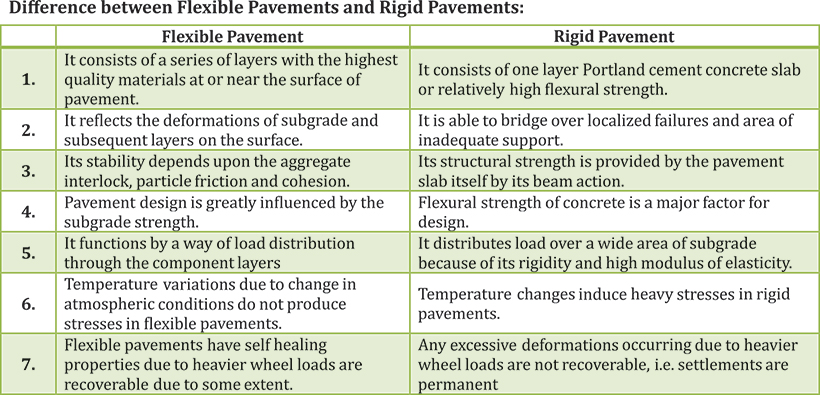Advantages and Disadvantages of Flexible Pavement
Flexible pavement is applied in extremely thick layers which gives it the ability to withstand heavy and more frequent traffic flows which makes it the ideal choice for major roadways and highways. Â Availability of low-cost types that can be easily built.
What Is The Difference Between Rigid Pavement And Flexible Pavement Quora
High initial costs.

. Write An Essay On Advantages And Disadvantages Of Flexible Pavements. Flexible pavement has very low flexural strength and is flexible in its structural action under vehicle loads. Asphalt or concrete will tend to buckle when conditions like frost cause upheaval or if the soil underneath is compacted or washed.
2 Heavy duty Pavements have generally the lowest cost. The strength of a flexible pavement is a result of. Advantages of Rigid Pavement Low maintenance and operation cost.
Reflection cracks occur in the overlay and reflect the crack pattern underneath. Flexible pavement is composed of hot mix asphalt HMA whereas rigid pavement is made of Portland cement concrete as prime structural material. The advantages and disadvantages of cement concrete pavement compared with flexible pavement are listed The net present value method of economic evaluation was applied It was found that the initial capital cost for producing rigid pavement is about twice that of producing flexible pavement.
Generally rough riding quality. High repair costs. There are two main types of pavement.
This mode has also the maximum flexibility for travel with reference to route direction time and speed of travel. What are the advantages and disadvantages of flexible pavement. More environment-friendly than flexible pavement.
The advantages of flexible pavements include -. Ii Flexible pavements consist of a series of layers with the highest quality materials at or near the surface. Repairs are easy and it can be opened and patched.
High initial costs. The strength of a flexible pavement. Advantages and Disadvantages of Rubber Patio Pavers.
The disadvantages of rigid pavements include. A significant disadvantage of this pavement is the high maintenance cost incurred. The disadvantages of rigid pavements include.
3 Pavement maintenance costs are up to 10 times cheaper than the same for flexible pavements. Vertical or horizontal movements will occur in the pavement beneath the asphalt overlay and produces cracks. With Flexible pavement traffic can be allowed to move on the pavement as soon as it has been rolled out Lay 182.
It has high flexural strength. The transportation by road is the only road which could give maximum service to one all. 1 Longer lasting 40 year Design Life some States in US ale already using 50 years and even this may increase in the future.
Now that we have known what flexible pavements are lets take a look at the advantages and disadvantages of flexible pavements. Advantages and disadvantages of flexible pavements. Flexible pavements do not require sealing due to their ability to adapt to the environment and are therefore less affected by cold or heat.
Ii Flexible pavements consist of a series of layers with the highest quality materials at or near the surface. Joints required for contraction and expansion. It has good resistance to petroleum products oils and chemicals.
Advantages of Flexible Pavement. Croney and Croney 1991 p9 defines a pavement as the structure which separates the tyres of the vehicles from the underlying materials. Since regular maintenance is required for this type of pavement repair work is fairly easy.
Joints required for contraction and expansion. Disadvantages Of Flexible Pavement. Generally rough riding quality.
Because it is a floating surface and has joints that make it flexible it can move as the soil beneath it changes. Â Ability to be easily opened and patched. Â Adaptability to stage construction.
Flexible pavements are more prone to damage and routine maintenance are needed to keep the surface in good form. In this pavement the wheel load stresses are transferred from grain to grain to the lower layers. Higher life span.
Here are some of the advantages that permeable pavement has to offer. It distributes loads in the broader area and can bear a large load due to slab action. It is possible to provide door to door service only by road transport.
What are the advantages and disadvantages of flexible pavement. High repair costs. Concrete has good.
Can be applied during pre-construction stage. The beneficial attributes of concrete pavements can be summarised as. Leather is a durable and flexible material that has both advantages and disadvantages.
The wheel load is distributed over a wider area and the stress is also decreased with the depth. Advantages of Flexible Pavements The curing period for the bituminous surface course is less and hence the surface can be opened to the traffic within 24 hours. Flexible pavements are the most commonly used form of pavement and have four component layers namely Sub-grade Sub-base and base and surface courses which are made up of materials like natural soils sand morrum etc are proved to be costly in terms of construction as well as.
Flexible pavements are of low-cost maintenance as it can be restored at the point of distortion by filling it with. Flexible pavements are of low-cost maintenance as it can be restored at the point of distortion by filling it with appropriate material.

Civil Made Easy Components And Advantage Disadvantages Facebook

Design Of Highway Flexible Pavement

Ppt Pavements Powerpoint Presentation Free Download Id 2403254

Pdf Alternative Binders For Flexible Pavement

Flexible Pavement Versus Rigid Pavement

Civil Made Easy Components And Advantage Disadvantages Facebook
Comments
Post a Comment